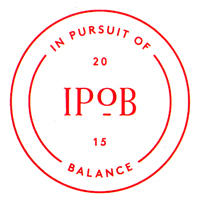Calera Wine Company
Calera 2013 Chardonnay, Mount Harlan. Whole-cluster pressed and aged for ten months in 30% new French oak. Very light color, this showed earth and spice aromas plus apple and pear fruit, plus touches of vanilla and lees. Medium-rich mouthfeel with a lively finish – this seemed somewhat tight and could use time in the cellar.
Calera 2012 Pinot Noir, Ryan Vineyard, Mount Harlan. From the youngest and most densely-planted of the Calera estate vineyards on Mount Harlan, first planted in 1998. 100% whole-cluster fermentation, aged for 18 months in 30% new French oak. Medium-light ruby color, with dried herb/stem notes upfront along with higher-toned plum and black cherry. Medium weight on the palate with lots of structure and a grippy tannic finish.
Calera 2003 Pinot Noir, Reed Vineyard, Mount Harlan. From vines planted in 1975, 100% whole-cluster fermentation, aged for 16 months in 15% new French oak. Medium-light brick/garnet color, this was all savory, spicy, and earthy aromas with very little fruit showing. Medium-bodied and still lively in the mouth, finishing with fine tannins.
Comments: Josh Jensen first planted vines in the limestone soil of Mount Harlan in San Benito County in the 1970s, and his Pinots in particular have been among California’s most distinctive over the years. The vineyard ranges up to 2,500 feet in elevation and is organically-farmed. All of the wines are fermented with native yeast. It’s always interesting to taste older vintages of Calera wines, and it was generous of them pour some at IPOB.
Ceritas Wines
 |
Ceritas 2013 Chardonnay, Peter Martin Ray Vineyard, Santa Cruz Mountains. From a block planted in rocky shale soil in the 1950s by Martin Ray. Light color, this displayed bright citrus aromas along with chalky, minerally notes. Medium-bodied with crisp acidity and clean finish.
Ceritas 2013 Chardonnay, Charles Heintz Vineyard, Sonoma Coast. From a vineyard just east of Occidental, with vines planted in 1980. Slightly darker color, featuring more intense citrus and green apple on the nose, plus touches of fresh herbs and wet stone. A bit richer on the palate than the previous wine, with vibrant acidity and a long, minerally finish, nice.
Ceritas 2013 Pinot Noir, “Costalina,” Sonoma Coast. Sourced from Hellenthal, Elliott, Porter-Bass, and Occidental Road vineyards. Fairly light ruby color, with red cherry, earth, and tea leaf aromas. Medium-light bodied with a lively texture and milder tannins.
Ceritas 2013 Pinot Noir, Elliott Vineyard, Sonoma Coast. From a vineyard in the Fort Ross-Seaview region, planted on volcanic soil, fermented with about 40% whole clusters. Medium-light color, this was savory and floral along with black cherry fruit and notes of mushroom/forest floor. A bit bigger and more structured than the “Costalina,” finishing with fine tannins, nice.
Ceritas 2013 Pinot Noir, “Old Shop Block,” Hellenthal Vineyard, Sonoma Coast. From own-rooted Calera vines in a separate block planted in sandy loam soil in 1980 by David Hirsch, not far from his own vineyard and from Elliott Vineyard, 50% whole-cluster fermentation. Medium-light ruby, more forward red fruit than the previous wine, plus bigger earth and spice components. More structured mouthfeel, with a stony mineral note on the long and moderately tannic finish.
Comments: John Raytek and his wife Phoebe Bass founded Ceritas in 2005, and the focus has been mainly on Sonoma Coast Chardonnay and Pinot Noir. Phoebe’s family owns Porter-Bass Vineyard, located near Forestville. All of the wines are made in older cooperage. John was on hand to pour their wines at the tasting. This was another very strong showing for the Ceritas wines.
Chanin Wine Company
Chanin 2013 Chardonnay, Los Alamos Vineyard, Santa Barbara County. Barrel-fermented in 15% new French oak. Very light straw color, this showed pear and spice aromas with a touch of lemonpeel. Medium-bodied with a lively texture and tasty finish.
Chanin 2013 Pinot Noir, Bien Nacido Vineyard, Santa Maria Valley. Fermented with about 40% whole clusters, aged in 15% new French oak. Medium-light ruby color, with earth, tea leaf, and black cherry on the nose. Medium weight with good structure and moderate tannins.
Chanin 2013 Pinot Noir, Sanford and Benedict Vineyard, Santa Maria Valley. Fermented with about 50% whole clusters. Medium-light ruby, featuring brighter red fruits, with touches of herbs, flowers, and wet stones. Bigger and more structured in the mouth, finishing with firm, chalky tannins – needs time but has great promise.
Comments: Chanin Wine Company was founded by Gavin Chanin in 2007. He has been making a single Chardonnay and Pinot from two Santa Barbara County vineyards each year. Current wines are sourced from some of the oldest plantings in the region. Chardonnays are whole-cluster pressed to tank but not settled before they’re racked to barrel and aged on the lees for up to 14 months. There is generally some whole-cluster fermentation on the Pinots but this varies by vineyard and vintage. Gavin poured a fine line-up again at IPOB this year.
Domaine de la Côte
Domaine de la Côte 2012 Pinot Noir, Sta. Rita Hills. Fermented with 50% whole clusters, aged in older oak. Medium-light color, showing upfront stemmy/herbal notes along with subtle red fruit, earth, and a touch of stony minerals. Medium-bodied and fairly structured, finishing with chalky tannins.
Domaine de la Côte 2012 Pinot Noir, Bloom’s Field, Sta. Rita Hills. From Mount Eden, Swan and Calera selections planted on shale soil, fermented with 100% whole clusters and aged in older oak. Medium-light color, this displayed intense cherry aromas along with flowers and spice. Medium weight with a lively texture and good structure, finishing with refined tannins, nice.
Comments: Domaine de la Côte grew out of the Evening Land project – Raj Parr and Sashi Moorman are part of a group who purchased it in early 2013. Sashi and Chris King first developed the vineyard sites for Evening Land in 2007, and they’re planted at high vine densities entirely to California heritage Pinot selections. The wines are produced in Lompoc and the 2011 vintage was the winery’s first. Sashi and Raj were on hand to pour at the tasting – Sashi poured for me and alternated between Domaine de la Côte and Sandhi Pinots, which were at the same table. The Bloom’s Field bottling has been a favorite two straight years.
Drew Family Cellars
Drew 2012 Pinot Noir, Weir Vineyard, Yorkville Highlands. Weir Vineyard is at higher elevation, planted in the 1990s. From Rochioli and DRC selections. Lighter color, with earth and tea leaf aromas upfront and subtle red fruits in support. Medium weight on the palate, finishing with moderate tannins.
Drew 2013 Pinot Noir, “Fog-Eater,” Anderson Valley. Sourced from Wentzel, Morning Dew Ranch and Balo vineyards. Medium-light ruby color, this featured black cherry and plum fruit, spice, and a floral note. This was more structured in the mouth, with lively acidity and bigger but refined tannins – a youngster but shows good potential.
Drew 2013 Pinot Noir, Morning Dew Vineyard, Anderson Valley. From a vineyard in the “Deep End” of the valley nearest the coast, planted in 2001 by Burt Williams. Rochioli and La Tâche selections. Medium-light color, this showed earth and leather notes along with cherry, spice, and forest floor aromas. Medium-bodied with moderate tannins.
Drew 2012 Pinot Noir, Valenti Vineyard, Mendocino Ridge. The vineyard is on Greenwood Ridge, about six miles from the ocean. Medium-light ruby, displaying a more savory character, with black cherry, herbs, plus touches of smoke, earth, and baking spice. Medium-bodied with good structure and a minerally component in the mouth, finishing with refined tannins, nice.
Drew 2005 Pinot Noir, Ashley’s Vineyard, Sta. Rita Hills. From the vineyard formerly known as Ashley’s (now part of Lindsay & Courtney West), planted in 1999 in the western portion of Sta. Rita Hills. Medium-light color, with a darker and more high-toned fruit profile, plus spice and a touch of sweet oak. Medium weight and a richer than the previous Pinots, finishing with fine tannins – a somewhat bigger Pinot but aging gracefully.
Comments: Jason and Molly Drew launched Drew Family Cellars in Santa Barbara County in 2000, In 2004, they purchased a property on a 1,300-foot ridgetop west of Anderson Valley, and they’ve focused mostly on fruit sources from Mendocino County ever since. The Drews planted their own estate vineyard in 2011 with eight clones of Pinot Noir – they’re located only about three miles from the ocean in the Mendocino Ridge AVA. Pinots are fermented with varying amounts of whole clusters (generally about 15%-50%) and are started with native yeasts, and are aged in French oak for 11-18 months. Jason poured his wines at IPOB, and he presented a group of very distinctive Pinots.
Failla Wines
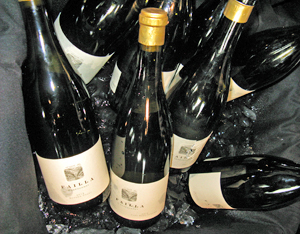 |
Failla 2013 Chardonnay, Estate Vineyard, Fort Ross-Seaview. From younger vines, with about ¼ of the wine made in concrete. Light color, with pear, lees, lemonpeel, and spice on the nose. Medium-light bodied, this had zippy acidity and a long, clean finish, nice.
Failla 2013 Chardonnay, Haynes Vineyard, Coombsville. From Wente clone vines planted in 1966 and dry-farmed, with about ¼ of the wine made in concrete. Light straw color, showing a more earthy character along with apple, spice, and vanilla/oak aromas. Medium weight on the palate with a lively texture and somewhat smoother finish.
Failla 2013 Pinot Noir, Sonoma Coast. Medium-light ruby color, this featured forward cherry fruit along with herb and spice notes. Medium-light bodied with good acidity and milder tannins.
Failla 2013 Pinot Noir, Keefer Ranch, Russian River Valley. Medium-light color, with bright strawberry and tea leaf aromas along plus touches of spice and sweet oak. Medium-bodied with lively acidity and refined tannins.
Failla 2013 Pinot Noir, Savoy Vineyard, Anderson Valley. Medium-light color, displaying forest floor and mushroom notes, black cherry, and spice. A bit bigger and more structured on the palate, finishing with firmer tannins – this will need time but shows great promise.
Comments: Originally called Failla Jordan, the winery was founded in 1998 by winemaker Ehren Jordan and his wife Anne-Marie Failla. Their first Pinot was a Keefer Ranch bottling from the 1999 vintage, and Chardonnay followed shortly afterwards. They first planted their estate vineyard in 1998 – it’s located on the far Sonoma Coast not far from Marcassin, Flowers, and Hirsch in the recently-designated Fort Ross-Seaview AVA. Pinot has been the core of the Failla production over the years, with bottlings continuing from Keefer Ranch and other cooler-climate sources, mostly from the Sonoma Coast. Ehren was on hand to pour his wines at the tasting, and this was one of the day’s standout producers.
Hirsch Vineyard and Winery
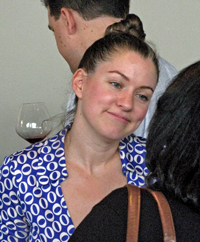 |
Hirsch 2012 Pinot Noir, “San Andreas Fault,” Estate, Sonoma Coast. Meant to present an overall picture of the estate vineyard, this includes both old and young vines from many vineyard blocks. Medium-light color, this showed red fruits, loads of spice, a hint of flowers, and a brushy forest floor note on the nose. Medium weight with good acidity and moderate tannins.
Hirsch 2012 Pinot Noir, “East Ridge,” Estate, Sonoma Coast. Sourced from some of the warmer vineyard blocks on the property. Medium ruby color, featuring a darker fruit profile, earth, and lots of spice. Bigger and more structured than the previous wine, with a grippier tannic finish.
Hirsch 2012 Pinot Noir, “Reserve,” Estate, Sonoma Coast. A selection of barrels from the oldest vineyard blocks. Medium-light ruby, this was less fruit-forward, with mushroom and earth aromas supported by black cherry and plum fruit, spice, and vanilla/oak. Another structured and fairly tannic Pinot that will need time in the bottle.
Comments: David Hirsch was one of the wine pioneers of the western Sonoma Coast, first planting his vineyard only about three miles from the ocean in 1980. The vineyard, scattered among hillsides and ridgetops above the fog line, is planted mostly to Pinot Noir along with a little Chardonnay, with many of the current vines dating form the early 1990s. The vineyard is being converted to biodynamic farming. Ross Cobb has been making the wines since the 2010 vintage.
Knez Winery
Knez 2013 Chardonnay, Demuth Vineyard, Anderson Valley. Light straw color, this had a slight matchstick sulfur note at first that blew off quickly, revealing bright lemon fruit, fresh herbs, and light touches of spice and vanilla/oak. Medium-bodied with a minerally note in the mouth, and a long, crisp finish, nice.
Knez 2013 Pinot Noir, Estate, Anderson Valley. Sourced from about 33% Demuth and 67% Cerise vineyards. Medium-light ruby color, displaying upfront red fruit, spice, and earth on the nose. Medium weight with lively acidity and a chalky note on the finish.
Knez 2012 Pinot Noir, Demuth Vineyard, Anderson Valley. Medium-light color, this showed less forward black cherry and plum fruit, earth, and forest floor, along with touches of flowers and spice. More structured mouthfeel with a firmer tannic finish.
Knez 2012 Pinot Noir, Cerise Vineyard, Anderson Valley. Medium-light color, with earth, leather, and spice upfront plus plummy fruit and spice. Bigger and more structured on the palate, finishing with grippier tannins.
Comments: Proprietor Peter Knez purchased both Cerise and Demuth vineyards a few years ago, and in 2009 he planted the new Knez Vineyard between the two. The hillside sites range from 700 to 1700 feet in elevation, above Boonville in Anderson Valley. Cerise Vineyard was planted in 1995 with ten Pinot clones, while Demuth was planted in 1982, with Wente clone Chardonnay and Pommard and Wädenswil Pinot clones. Farming of the vineyards is transitioning to biodynamic, and the first vintage for the winery was in 2009. Anthill Farms’ Anthony Filiberti is the winemaker and was behind the table at the event. The Chardonnay was a standout while the Pinots will benefit from more time.
Kutch Wines
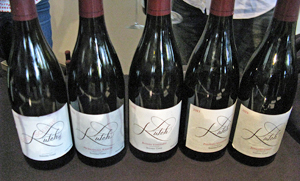 |
Kutch 2013 Pinot Noir, Bohan Vineyard, Sonoma Coast. From dry-farmed, head-trained vines. Medium-light color, this showed cranberry and strawberry fruit along with a stemmy/herbal component and touches of stony minerals and spice. Medium-light weight with a bright texture and moderate tannins, nice.
Kutch 2013 Pinot Noir, McDougall Ranch, Sonoma Coast. Medium-light color, with black cherry and plum, earth, and herbs on the nose. Bigger and more structured on the palate, with fine acidity and fairly grippy tannins.
Kutch 2013 Pinot Noir, Falstaff Vineyard, Sonoma Coast. The vineyard is near Freestone, planted to 115, 777, and 828 clones. Medium-light ruby, this was more fruit-forward with black cherry, lots of spice, and tea leaf. Medium-bodied, with more refined tannins on the finish than the McDougall bottling.
Kutch 2013 Pinot Noir, “Sans Soufre,” Sonoma Coast. Sourced from Falstaff Vineyard, a separate bottling with no added sulfur during the winemaking process. Medium-light ruby color, more focused red fruit along with touches of flowers, spice, and herbs on the nose. Medium weight on the palate with a brighter texture than the previous wine, finishing with firmer tannins – quite distinct from the regular Falstaff bottling, this is nice now, though it might be worth trying some bottle aging.
Comments: Jamie Kutch’s first wine was from the 2005 vintage, and he’s worked exclusively with Pinot Noir from the start. Over the years he’s changed his winemaking style, having become more strongly influenced by the wines of Burgundy. The vineyard sources are mostly from the Sonoma Coast, and the wines I tasted were all fermented with 100% whole clusters. Jamie was on hand to pour at the IPOB tasting, and this was one of the strongest line-ups of wines I tried there.
|
LaRue Wines
LaRue 2012 Pinot Noir, Sonoma Coast. Sourced from Rice-Spivak and Emmaline Ann vineyards. Medium-light color, this featured strawberry aromas along with earth, tea leaf, spice, and a stony mineral note. Medium-light weight, this had vibrant acidity and a bright, zippy finish, nice.
LaRue 2012 Pinot Noir, Rice-Spivak Vineyard, Sonoma Coast. Medium-light ruby color, this was less fruit forward, with big spice and wet stone elements along with red fruit and dried herbs. Medium-bodied with a bigger structure and firmer tannins than the previous wine – showing nicely now and has plenty of promise for development in the cellar.
LaRue 2012 Pinot Noir, Coastlands Vineyard, Sonoma Coast. Medium-light ruby, with a darker fruit profile along with lots of spice and touches of forest floor and minerals. Moderately big and structured on the palate, with chalky tannins on the finish.
Comments: LaRue makes exclusively Sonoma Coast Pinot Noir. Owner/winemaker Katy Wilson (also the associate winemaker at Kamen Estate) launched the LaRue label with a Sonoma Coast Pinot from the 2009 vintage. Rice-Spivak Vineyard is located south of Sebastopol, while Emmaline Ann is near Freestone. She’s worked at a variety of noted wineries, including Craggy Range in New Zealand, Testarossa, and Flowers. Katy poured her wines at the event, and her Pinots showed the clearest minerality across the board of any producer I tried there.
Liquid Farm
 |
Liquid Farm 2013 Chardonnay, “Golden Slope,” Sta. Rita Hills. Sourced from a variety of Sta. Rita Hills vineyards, made in 82% neutral and 18% new oak. Light straw color, this showed pear, spice, earth, and a touch of vanilla/oak. Medium-bodied with vibrant acidity and a slightly chalky mineral note on the finish, nice.
Liquid Farm 2013 Chardonnay, “Four,” Sta. Rita Hills. Sourced from Rita's Crown, Clos Pepe, Kessler-Haak, and Radian vineyards, made in 25% new oak. Light yellow-straw color, with slightly riper aromas of pear and stone fruit, spice, lees, and vanilla/oak. Fairly rich, creamy mouthfeel with a long, smooth finish.
Comments: Liquid Farm is the label of Jeff & Nikki Nelson. Established in 2009, Liquid Farm started with two wines – “White Hill” and “Golden Slope” – inspired respectively by Chablis and Meursault. The focus has been almost entirely on Chardonnay from the Sta. Rita Hills appellation, but they’ve recently branched out to Santa Maria Valley fruit sources and also make a fine Mourvèdre Rose (and Pinot Noir will be added to their line-up soon). The Liquid Farm winemaker is James Sparks. I passed on tasting a number of wines that I had tried with Jeff and Nikki in January – favorites at that time included the “White Hill” and “La Hermana” bottlings.
Lutum Wines
Lutum 2013 Chardonnay, Durell Vineyard, Sonoma Coast. Made in 33% new French oak. Light straw color, this displayed pear and stone fruit aromas along with lees, spice, and vanilla/oak. Medium-bodied, with a moderately creamy mouthfeel and lively finish.
Lutum 2012 Pinot Noir, Sanford & Benedict Vineyard, Sta. Rita Hills. Aged in 25% new French oak. Medium-light ruby color, with black cherry and darker fruit, tea leaf, spice, and earth on the nose. Medium weight with good acidity and moderate tannins.
Lutum 2013 Pinot Noir, Durell Vineyard, Sonoma Coast. Entirely from 667 clone, aged in 33% new French oak. Medium-light color, showing a more savory profile with herbs, mushrooms, spice, and black cherry fruit, with a touch of sweet oak in the background. Medium-bodied with a bit bigger structure than the previous wine, finishing with refined tannins, nice.
Comments: Lutum is a fairly new label founded by vintner Gavin Chanin and entrepreneur Bill Price of Classic Wines and Price Family Vineyards – owners of Durell and Gap’s Crown vineyards among others and with ownership interests in several wine labels. The name comes from the Latin word for soil and is a reference to the desire to let the wines express the vineyards’ terroir. The first Lutum vintage was 2011, although 2012 was the first year of any significant production. All of the Pinot fruit is destemmed, and there is no skin contact with the Chardonnays. Wines are typically aged in around 20%-33% new French oak. Gavin poured the wines at IPOB.
Matthiasson Wine
Matthiasson 2013 Chardonnay, Linda Vista Vineyard, Napa Valley. From a vineyard in the Oak Knoll area, the fruit was whole-cluster pressed and made in neutral oak with 40% malolactic fermentation. Very light color, this showed pear and fig aromas along with an herbal note. Medium-light bodied with a bright mouthfeel and long, clean finish, nice.
Matthiasson 2012 Chardonnay, Michael Mara Vineyard, Sonoma Coast. From a rocky vineyard site west of Sonoma, with fruit from both an early and late pick, made in neutral oak with 100% malolactic fermentation. Very light straw color, with stone fruit, lees, and spice on the nose. Medium weight on the palate, with a lively texture and smooth finish.
Comments: Steve Matthiasson is a highly-regarded viticulturist in addition to making wine, and he has an impressive list of clients, mainly in Napa. He and his wife Jill run the winery and produced their first commercial vintage in 2003. Not surprisingly, Steve is very hands-on when it comes to the farming of his vineyard sites. Steve and Jill were behind the table at the IPOB tasting. I’d tasted a couple of other very good Matthiasson white wines in the past, and trying these two Chardonnays showed his sure touch on that variety as well – both good and very different from each other.
Mindego Ridge Vineyard
Mindego Ridge 2013 Chardonnay, Santa Cruz Mountains. Made in 15% new French oak. Light straw color, featuring pear, spice, and earth aromas. Medium-bodied with crisp acidity on the finish.
Mindego Ridge 2013 Pinot Noir, Santa Cruz Mountains. Aged in 25% new French oak. Medium-light ruby color, with intense raspberry aromas along with notes of flowers, spice, and sweet oak in the background. Medium-bodied with moderately chalky tannins on the finish, this was an attractive wine for the beautiful, pure aromatics.
Comments: David & Stacey Gollnick’s Mindego Ridge label is named for the estate vineyard site, on the western slope of the Santa Cruz Mountains. They planted the ten-acre vineyard in 2009, on rocky shale soil. The 2013 wines are their inaugural release, and Ehren Jordan is the winemaker. David & Stacey were on hand to pour their wines at IPOB.
Mount Eden Vineyards
Domaine Eden 2012 Chardonnay, Santa Cruz Mountains. Light straw color, this displayed pear and stone fruit aromas along with earth, spice, and vanilla/oak notes. Medium-rich mouthfeel, with a slightly chalky finish.
Mount Eden 2011 Chardonnay, Estate, Santa Cruz Mountains. Medium-light straw color, showing a more earthy character along with apple and pear fruit, spice, herbs, and a background of sweet oak. Richer texture than the previous wine but with plenty of lively acidity, this had a stony mineral note on the long, smooth finish – nice now but deserving of more time in the cellar.
Comments: Mount Eden is one of California’s most historic vineyard sites, with a story that extends back to legendary vintners Paul Masson and Martin Ray. The vineyard at Mount Eden was replanted beginning in 1984 with a variety of Dijon and “heritage” clones, including some propagated from the original vines planted there. Chardonnays are whole-cluster pressed and barrel-fermented in new and one-year old French oak, where they are aged on the lees for ten months, then bottle-aged for two years. Pinots undergo native yeast fermentations in small lots, then go into mostly new oak along with some one-year old oak, and barrel-aged for about 18 months. Proprietor/winemaker Jeffrey Patterson poured his wines at the IPOB tasting. I skipped the two Pinots to save some time, as I knew I would have the opportunity to taste them at another event shortly after this one.
Native9 Wines
Native9 2011 Pinot Noir, Rancho Ontiveros Vineyard, Santa Maria Valley. Fermented with about 60% whole clusters and aged two years in barrel. Medium-light ruby color, displaying cranberry and cherry fruit along with a very savory component, plus notes of flowers, spice, and earth. Medium-bodied and quite structured, with chalky tannins on the long finish – this has developed very well in the past year and has the potential to become even better with more time, very nice.
Native9 2012 Pinot Noir, Rancho Ontiveros Vineyard, Santa Maria Valley. Fermented with about 95% whole clusters, to be released this fall. Slightly lighter color, with brighter and more forward fruit, featuring black cherry, tea leaf, spice, and a background of vanilla/oak. Medium weight with a lively mouthfeel and refined tannins – this will also benefit from time in the cellar but it’s already showing well.
Comments: Native9 Wines is the project of grower James Ontiveros – a ninth-generation Californian. His eight-acre vineyard in Santa Maria Valley was planted in 1997-2000 with a variety of Pinot clones, and the vineyard is farmed organically. Yields in the sandy vineyard site are low, generally around 1.25 tons per acre. The first release of Native9 Pinot Noir was in 2004, and the winemaker is Paul Wilkins. Typically a high percentage of whole clusters are used – often 100% – and fermentation is with native yeast. James was on hand to pour the wines at the tasting. The 2011 Pinot was a particular standout and has really benefited from some time in the bottle.
Peay Vineyards
Peay 2013 Pinot Noir, Sonoma Coast. Medium-light ruby color, this had big, upfront aromas of black cherry along with earth, forest floor, and sweet oak. Medium-bodied with a lively texture and fine tannins, a good fruit-forward style Pinot.
Peay 2013 Pinot Noir, “Pomarium,” Estate, Sonoma Coast. Medium-light ruby, this showed more earth and spice on the nose, with black cherry, flowers, and herbs in support. Medium weight with a slightly richer texture than the previous wine, finishing with firm but refined tannins, nice.
Peay 2012 Pinot Noir, “Scallop Shelf,” Estate, Sonoma Coast. Medium-light color, with a deeper, darker fruit profile, plus earth, tea leaf, and spice. Bigger and more structured, this had a more tannic finish and could still use some time to develop.
Comments: Peay Vineyard is located only about four miles from the ocean in the far northwest reaches of the Sonoma Coast AVA near the town of Annapolis. The Peay label is run by the husband-and-wife team of Nick Peay, who farms the vineyard, and Vanessa Wong, who makes the wine, and by Nick’s brother Andy, who handles the marketing and sales work. Nick and Andy poured at IPOB this year. The first estate plantings were in 1998, and currently include 34 acres of Pinot Noir and 7 acres of Chardonnay within the 51-acre vineyard, which is farmed organically. Many of the Peay wines are made entirely from estate fruit, though some include purchased fruit as well. I got to the Peay table at the very end of the tasting and only had time to taste a few of their wines.
Red Car Wine Company
Red Car 2012 Chardonnay, Hagan Vineyard, Sonoma Coast. From a vineyard west of Occidental, all barrel-fermented with 100% malolactic fermentation. Light straw color, this showed apple and stone fruit, lemonpeel, and lees. Medium-bodied with bright acidity and a slightly chalky texture on the finish, nice.
Red Car 2012 Chardonnay, Ritchie Vineyard, Sonoma Coast. From Old Wente clone vines planted nearly 40 years ago. Light yellow-straw color, this had riper stone fruit and pear aromas along with spice and a background of vanilla/oak. Richer mouthfeel than the previous wine, this had a long, smooth finish.
Red Car 2014 Rosé of Pinot Noir, Sonoma Coast. Whole-cluster pressed. Very light salmon-pink color, featuring intense aromas of strawberry fruit along with floral and herbal notes. Medium-light bodied with a lively texture and crisp, refreshing finish, nice.
Red Car 2012 Pinot Noir, Doc’s Ranch Vineyard, Sonoma Coast. 100% Swan clone, from vines planted in 1999. Medium-light ruby color, with cranberry and strawberry fruit, tea leaf, and forest floor notes. Medium-bodied with a bright mouthfeel and lively finish with fine tannins, nice.
Red Car Estate 2012 Pinot Noir, Estate Vineyard, Fort Ross-Seaview. Slightly darker color, this displayed black cherry, spice, and dried herbs, with a touch of sweet oak in the background. Medium weight on the palate, finishing with a slight stony mineral note and moderate tannins.
Red Car 2012 Pinot Noir, Hagan Vineyard, Sonoma Coast. Medium-light color, featuring higher-toned aromas of red fruits, tea leaf, and earth. Medium-bodied with a firm structure and moderately grippy tannins on the finish.
Comments: Red Car was established in 2000 by Carroll Kemp and Mark Estrin, who passed away in 2005. Carroll continues to head up the label and the winemaking, and he was on hand to pour his wines at IPOB. Originally located in Santa Barbara County and focused on fruit from that area, Red Car moved to the Sonoma Coast in the mid-2000’s, planting an estate vineyard on King Ridge, north of Hirsch Vineyard in the Fort Ross-Seaview AVA. The style of Red Car’s wines has evolved considerably along with the change in vineyard locations, and Carroll poured a strong group of wines across the board.
Sandhi Wines
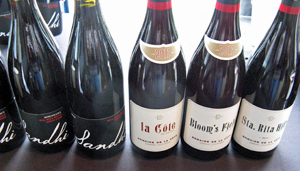 |
Sandhi 2013 Chardonnay, Sta. Rita Hills. Very light straw color, this showed upfront bright lemony fruit, spice, lemonpeel, and earth. Medium-bodied with a lively texture, this had a stony mineral component on the finish, nice.
Sandhi 2013 Chardonnay, Sanford & Benedict Vineyard, Sta. Rita Hills. From Mount Eden clone vines planted in 1971. Light color, this had a matchstick/sulfur note that took some time to blow off, revealing apple and pear fruit, spice, and a touch of vanilla/oak. Richer texture than the previous wine, with good acidity and a long finish.
Sandhi 2012 Pinot Noir, Sta. Rita Hills. Medium-light color, with dried herb, tart cherry, and earth aromas. Medium weight on the palate, finishing with fine tannins.
Sandhi 2012 Pinot Noir, Rinconada Vineyard, Sta. Rita Hills. Slightly darker ruby color, displaying a darker fruit profile along with spice and orangepeel. More structured mouthfeel, with chalky tannins on the finish.
Comments: Sandhi was established in 2010 by IPOB co-founder Rajat Parr, wine director for Michael Mina Restaurants, Charles Banks, former owner of Jonata and Screaming Eagle, and winemaker Sashi Moorman. The first wines released were from the 2009 vintage, and most of the winery’s fruit comes from the Sta. Rita Hills AVA. The climate and the diatomaceous soil found in part of that region were factors in choosing these vineyard sources. Chardonnays are crushed and pressed to tank, then racked straight to mostly older cooperage for fermentation and aging. Pinots are mostly fermented with whole clusters, and all of the wines are fermented with native yeast. Raj and Sashi poured the wines at the tasting – Sashi poured for me and alternated between Sandhi and Domaine de la Côte Pinots.
Varner Wine
Varner 2013 Chardonnay, Santa Barbara County. Varner’s first Santa Barbara Chardonnay, sourced from El Camino Vineyard in the Los Alamos area. Light straw color, this showed upfront stone fruit and tropical fruit aromas along with spice and a touch of sweet oak. Medium-light weight, this had a long smooth finish.
Varner 2013 Chardonnay, Spring Ridge Vineyard, “Amphitheater Block,” Santa Cruz Mountains. Sourced from 29-year old own-rooted Wente clone vines. Light straw color, with an earthy and minerally profile, plus apple, lemonpeel, spice, and lees on the nose. Moderately rich with fine acidity and a clean finish.
Varner 2013 Chardonnay, Spring Ridge Vineyard, “Home Block,” Santa Cruz Mountains. From own-rooted 30 year-old Clone 4 vines. Light color, featuring lemon, earth, wet stone, spice, and undertones of vanilla/oak. Medium-rich mouthfeel along with lively acidity, this had a long, tasty finish, nice.
Comments: Twin brothers Jim and Bob Varner run the Varner and Neely labels, as well as the Foxglove label. They farm 14-acre Spring Ridge Vineyard in the Portola Valley area of the Santa Cruz Mountains, first planted in 1980 and owned by the Neely family. Originally planted to Chardonnay and Gewürztraminer, Pinot Noir was added in 1997, and the Gewürz was grafted over to more Pinot in 2006. The vineyard is broken up into a number of separate blocks, and it is farmed organically. Some of the vines are own-rooted. The Chardonnays are all barrel-fermented and aged for eight months in about 25% new French oak. Little or no whole clusters are included in the Pinot fermentations, and the Pinots are aged in 25-30% new oak. All fermentations take place with native yeast. Both Bob and Jim poured their wines at IPOB, and all their Chards were very good.
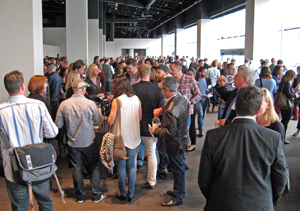 |
|


